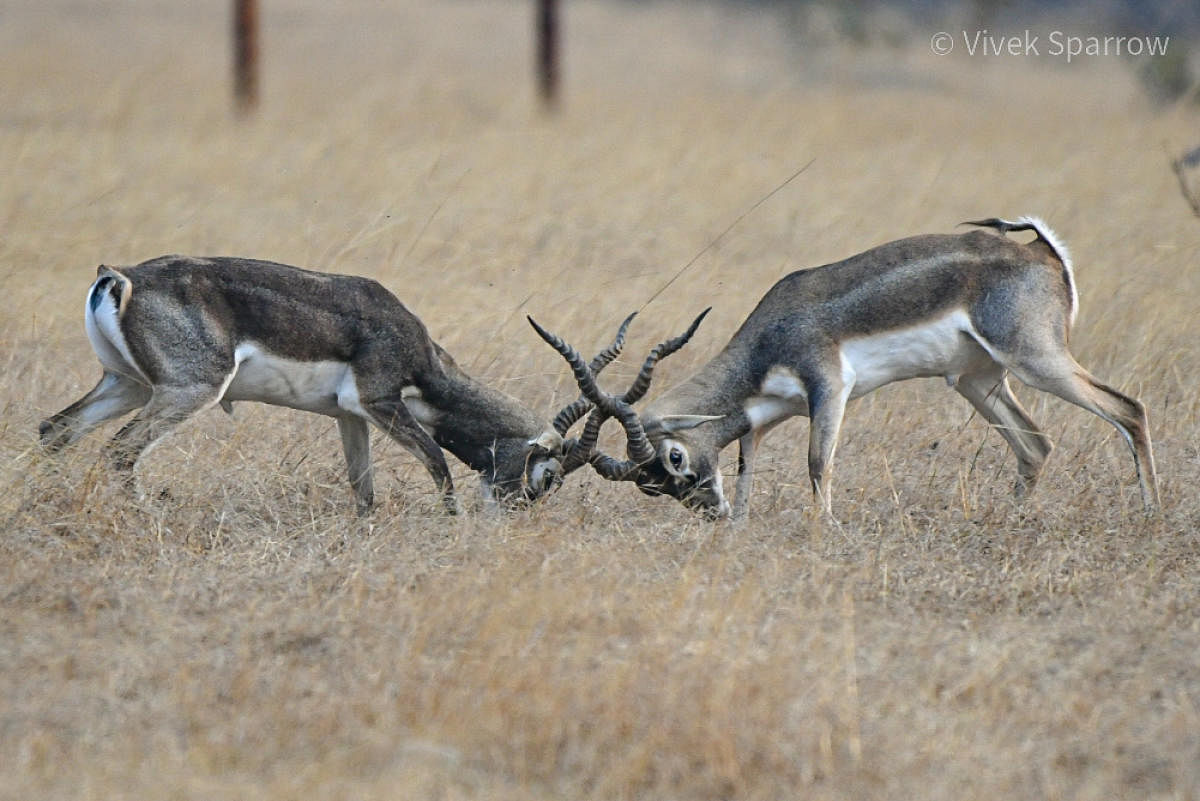

The recent sighting of two herds of nilgai in the grasslands of Aurad in Bidar, and along the regions bordering Telangana and Maharashtra has kindled hope among environmentalists and concern among farmers.
It has been more than a decade since wildlife enthusiasts have been able to capture images of the nilgai or blue bull, Asia’s largest antelope, in the region.
Forest department officials and activists are unsure if these nilgai are ‘original residents’ or have migrated to Karnataka from Maharashtra and Telangana.
However, with reports about the presence of the nilgai, Bidar now has the distinction of being the only place in Karnataka to house all four types of antelopes, including the Chinkara, four-horned antelope and blackbuck.
It wasn’t so long ago that the hoofbeats of these antelopes resounded across the Deccan. But today, their presence has been relegated to a small protected portion in the state. Unfortunately, these herbivores are now considered vermin and permissions are being sought from the Forest Department to hunt them as they destroy crops.
Several North Indian states have permitted farmers to kill nilgai because, unlike the other antelopes, they damage large tracts of fields. Recently, a video of a farmer burying a nilgai alive using earthmoving machines in Bihar had gone viral on social media inviting criticism of the Environment Ministry for allowing the culling of these animals.
While there hasn’t been a detailed study done on these antelopes in Karnataka, conservators working on predators and other umbrella species say that numbers of antelopes are steadily declining, while the human-animal conflict is on the rise.
Dwindling predators
Experts attribute the increase in human-antelope conflict to two major reasons— change in the topography of the grass/barren land and dwindling numbers of predators.
Additional Principal Chief Conservator of Forest (Legal Cell) Vijay Mohan Raj says the advent of irrigation projects in Deccan Plateau, especially the construction of dams, drawing water canals and introduction of borewells, has changed the topography of the region.
“These so-called wastelands used to be the house of antelopes,” Mohan Raj says and adds that farmers who earlier cultivated ‘low-value crops’ such as millet have now started growing ‘high-value crops’ such as onion, grams and others.
While the animals used to feed on crops even then, the farmers used to forgo their losses. But now, the same farmers demand that these antelopes be termed vermin and be culled.
Despite all these developments, Bidar has retained a large area of its grasslands.
Mohan Raj says the sighting of nilgai in
Bidar is a sign of the resilience of these animals and the conservation efforts of local people. “Worrying about nilgai becoming pests is a bit far-fetched as of now and the animals should not be disturbed.”
Wildlife activist Vivek Baburao and MSc Zoology student Jyoti M Biradar, who photographed the nilgai in Aurad, say the only reason all four antelopes are found in the region is because of its untouched grasslands. “We can safely say that parts of Aurad and Chincholi resemble the Savanna grasslands of Africa.”
Vivek says that the Forest Department has to take immediate steps to protect these animals as many of them are falling prey to the electric fences around the farms.
‘They are the solution’
Deccan Conservation Foundation Founder Indrajit Ghorpade asserts that antelopes are not a problem but the solution to the human-animal conflict. Predators such as leopards, wolves, fox, hyena and others are forced to hunt cattle as their natural prey — antelopes — are disappearing from their habitat. The easy availability of such natural prey would automatically reduce the human-animal conflict, he says.
There are several books that record the presence of cheetahs and tigers in the Sandur belt of Ballari district. Today, the two predators are ‘extinct’ in the region, Ghorpade says and adds that the introduction of nilgai in low prey density protected areas such as Daroji Sloth Bear sanctuary, Kappatagudda, Sandur and others can enhance the biodiversity of the area.
Taking people into confidence
M R Desai, whose four-decade-long struggle resulted in a small patch of green land near Bilagi in Bagalkot district being recognised as the Chinkara Sanctuary, says antelopes may not turn into ‘pests’ if we take local people into confidence and raise awareness about the importance of these herbivores.
Dwindling of predators such as wolves, leopards and jackals had turned chinkara or Indian gazelle into a nuisance to the people. “Along with the help of the Forest Department, we started creating awareness among people about the role these chinkaras play in nature. Soon, people in and around Bilagi started protecting them,” he says.
Ranebennur Blackbuck Sanctuary Range Forest Officer Ganesh Shetty says the Forest Department is also making an all-out effort to ensure that farmers do not harm blackbucks in retaliation for the crop damage they cause. “On an average every year, the Forest Department has been compensating 200 farmers whose fields are adjacent to the sanctuary,” he said.